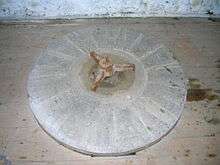Millrind

A millrind or simply rind is an iron support, usually four-armed or cross-shaped, for the turning ("runner") stone in a pair of millstones.
The rind is affixed to the top of the main shaft or spindle and supports the entire weight of the runner stone, which can be as much as several tons. The rind is necessary because the grain is fed through the runner stone's central hole, so the spindle cannot be inserted through it like a cartwheel on an axle.
The face of a runner stone usually has a carved depression, called the "Spanish cross", to accommodate the millrind.
In heraldry





A millrind or fer de moline (French, literally "iron of a mill") is a rare heraldic charge, which takes its name from its form based on the physical object. An example is found in the arms of Sir William Saunsum,[2] blazoned in a roll of arms temp. Edward II. The exact form differs in variety from that illustrated in the Saunsum arms to a form almost identical to the "cross recercelée", appearing as an exaggerated form of the "cross moline", as borne by Ferre.[3] The evidence for the cross recercelée variety being correctly seen as a fer de moline, confirmed by Boutell,[4] is that the arms of Ferre were certainly designed to be canting arms, and that the arms sculpted at Butley Priory are indeed those of Guy Ferre (d.1323), who acquired the advowson of that place shortly before the gatehouse on which they appear was built.[5] Planché states "the modes of representing the cross moline, or millrind, are endless".[6]
The De Molines family of Sefton, England, whose surname eventually evolved into Molyneux, bore the cross moline on their coat of arms since early medieval times.
| Wikimedia Commons has media related to Millrinds. |
References
| Look up millrind in Wiktionary, the free dictionary. |
- ↑ fr:Liste des meubles héraldiques fr.wikipedia
- ↑ Possibly William Saunsum of Watford
- ↑ Fox-Davies, A.C. A Complete Guide to Heraldry, London, 1985, p.220: fer-de-moline "depicted in varying forms"
- ↑ Boutell, Charles. Heraldry Historical & Popular, London, 1863, p.45 & plate LXIX, no.153A (in the latter drawing misprinted "Hursthelve" in place of Ferre correctly given in the text)
- ↑ Richard Mortimer (ed.), Leiston Abbey Cartulary & Butley Priory Charters, Suffolk Records Society, 1979, charter no.115
- ↑ Planché, J.R. The Pursuivant of Arms; or Heraldry Founded upon Facts, London, 1873, p.51